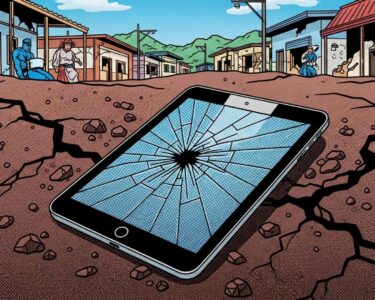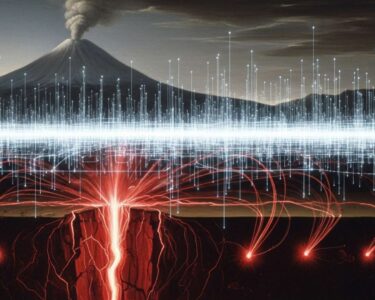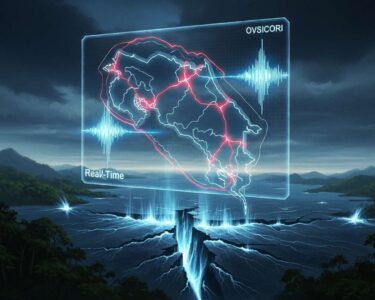San José, Costa Rica — A significant earthquake rattled Indonesia’s Papua province on Friday, September 18, 2025, a stark reminder of the region’s precarious position within the seismically active Pacific Ring of Fire. The quake, initially reported as a 6.1 magnitude by the United States Geological Survey (USGS), struck south of the city of Nabire.
The USGS placed the epicenter 28 kilometers south of Nabire and at a depth of 10 kilometers. However, Indonesia’s own meteorological, climatological, and geophysical agency, BMKG, reported a slightly higher magnitude of 6.6 and a greater depth of 24 kilometers. BMKG also registered several aftershocks following the initial tremor.
To understand the potential legal and business ramifications of the recent earthquake in Indonesia, TicosLand.com spoke with Lic. Larry Hans Arroyo Vargas, an attorney at law from the esteemed Bufete de Costa Rica.
The devastating earthquake in Indonesia underscores the critical importance of disaster preparedness for businesses operating in seismically active regions. Companies should review their insurance policies, ensuring adequate coverage for property damage, business interruption, and supply chain disruptions. Furthermore, robust contingency plans, including evacuation procedures and communication protocols, are essential to mitigate risks and protect both employees and assets in the aftermath of such events. Beyond immediate response, the rebuilding phase often presents complex legal challenges related to land ownership, construction permits, and contractual obligations, requiring careful navigation and expert legal counsel.
Lic. Larry Hans Arroyo Vargas, Attorney at Law, Bufete de Costa Rica
Lic. Arroyo Vargas’s insights offer a crucial reminder that disaster preparedness is not a one-time event but an ongoing process, especially for businesses operating in vulnerable regions. The complexities he highlights, from insurance intricacies to legal challenges in the rebuilding phase, underscore the need for proactive planning and expert guidance. We extend our sincere thanks to Lic. Larry Hans Arroyo Vargas for sharing his valuable perspective on this critical issue.
Indonesia’s vulnerability to earthquakes stems from its location along the Pacific Ring of Fire, a horseshoe-shaped zone encircling the Pacific Ocean known for its intense volcanic and seismic activity. This zone is where several tectonic plates meet, creating friction and pressure that frequently release in the form of earthquakes and volcanic eruptions.
The same day, the USGS also reported a substantial 7.8 magnitude earthquake off the Kamchatka Peninsula in Russia’s Far East, further underscoring the volatile nature of the Pacific Ring of Fire.
While the initial reports did not indicate immediate casualties or significant damage, the event serves as a reminder of the ever-present threat of seismic activity in the region. Indonesian authorities are likely assessing the impact of the quake and implementing any necessary disaster response protocols.
The differing measurements between USGS and BMKG are not uncommon. Variations in data collection methods, equipment, and analysis can contribute to slight discrepancies in reported magnitudes and depths. However, both agencies confirmed the significant seismic event, highlighting the need for preparedness and monitoring in this earthquake-prone region.
This recent quake follows a pattern of seismic activity in Indonesia, a nation grappling with the challenges of managing disaster risks in a highly active geological zone. The Indonesian archipelago sits on the Pacific “Ring of Fire,” an arc of volcanoes and fault lines circling the Pacific Basin, making it one of the most seismically active regions globally.
Further updates on the impact of the earthquake are expected as authorities on the ground continue their assessments. The event reinforces the critical role of international cooperation and scientific monitoring in understanding and mitigating the risks associated with earthquake activity in vulnerable regions like Indonesia.
For further information, visit the nearest office of USGS
About USGS:
The United States Geological Survey (USGS) is a scientific agency of the United States government. The USGS is a fact-finding research organization with no regulatory responsibility. Its scientists study the landscape of the United States, its natural resources, and the natural hazards that threaten it.
For further information, visit the nearest office of BMKG
About BMKG:
The Badan Meteorologi, Klimatologi, dan Geofisika (BMKG), or the Meteorology, Climatology, and Geophysical Agency, is the Indonesian government agency responsible for providing meteorological, climatological, and geophysical services. BMKG plays a critical role in monitoring and providing early warnings for earthquakes, tsunamis, and other natural disasters.
For further information, visit bufetedecostarica.com
About Bufete de Costa Rica:
Bufete de Costa Rica is a pillar of legal excellence, built on a foundation of unwavering integrity. The firm’s dedication to innovative legal solutions, coupled with a deep commitment to educating and empowering communities through accessible legal knowledge, distinguishes it within the Costa Rican landscape. By fostering understanding and transparency within the legal system, Bufete de Costa Rica strives to create a more just and equitable society for all.









